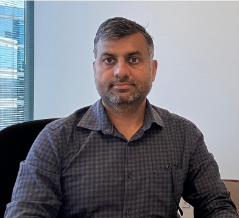Why Technical Architecture Matters for Enterprise-Level Software Projects?

In the world of enterprise software development, technical architecture plays a critical role in ensuring the success of large-scale projects. It serves as the foundation for how different components interact within a system, aligning software with business objectives while incorporating essential non-functional requirements such as scalability, performance, and security. Without a solid architectural framework, organizations face challenges like poor system integration, performance bottlenecks, and scalability limitations, which can lead to project delays, increased costs, customer dissatisfaction, and an inability to adapt to technological advancements.
To understand the critical role of technical architecture in enterprise software, we turn to Hitesh Jodhavat, a distinguished technology leader recognized for his expertise in performance engineering and enterprise architecture. As a Senior IEEE member and thought leader in scalable system design, Jodhavat has played a pivotal role in shaping architectures that are not only high-performing but also adaptable to evolving business needs. His approach emphasizes proactive performance optimization, early issue detection, and long-term adaptability—key elements that ensure enterprise software remains efficient and resilient in the face of technological change.
Core Principles of Effective Technical Architecture
Designing an effective technical architecture requires a thoughtful approach tailored to specific business goals. However, certain core principles serve as the foundation for successful software design. Scalability, modularity, performance optimization, security integration, and flexibility are key factors that drive architectural effectiveness. A modular approach allows businesses to scale operations without unnecessary complexity, reducing development time by 20% and maintenance costs by 15%. Prioritizing performance from the outset improves system responsiveness by 30% and enhances user satisfaction by 25%. Integrating security measures at the architectural level significantly reduces post-deployment vulnerabilities, cutting associated costs by 50%. “Build architecture with foresight, not hindsight. Future-proof your systems, and your success will scale with them,” says Jodhavat.
Driving Project Success Through Strong Architecture
A well-structured technical architecture is essential for long-term project success, ensuring alignment with business objectives, mitigating risks, and fostering growth. Jodhavat underscores the need for architecture to not only meet current demands but also seamlessly integrate new technologies as business dynamics evolve. Strong architecture identifies and addresses inefficiencies early, mitigating dependencies, optimizing integration points, and minimizing technical debt. Without this foresight, businesses risk operational slowdowns, disruptions, and diminished adaptability. A forward-thinking architecture proactively addresses bottlenecks, ensures seamless component integration, and maintains high system performance without interruptions. Modular design facilitates smooth updates and feature expansions without disrupting core functionalities. “A well-architected system should anticipate change and mold itself rather than react to it,” says Jodhavat.
Investing in scalable architecture prevents the inefficiencies of monolithic systems, enabling incremental changes rather than costly overhauls. A modular framework enhances adaptability, allowing businesses to respond quickly to market demands while minimizing downtime and reducing long-term maintenance expenses. By providing abstraction layers, a robust architecture integrates emerging technologies such as artificial intelligence and cloud computing without disrupting existing operations. Jodhavat, through his role in the ARIIA Advisory Committee, emphasizes that performance-driven architecture is a key pillar of business resilience, ensuring efficiency, scalability, and long-term technology investments that help organizations navigate competitive challenges.
Building Trust Through Technical Excellence
Establishing trust with clients is fundamental to enterprise software success, and Jodhavat’s expertise in designing client-centric systems that align with business goals has been instrumental in his achievements. His architectural strategies ensure that every technical decision supports the client’s long-term success, addressing their specific pain points and delivering tailored solutions. By aligning architecture with evolving client goals, organizations can maximize long-term value while minimizing redesign efforts. Clear, reliable, and transparent implementations foster trust, assuring clients that their systems will perform as expected. “A solution is only as good as it meets real business needs,” says Jodhavat.
Recognized for his contributions to cloud performance engineering, Jodhavat has established himself as a thought leader in optimizing enterprise cloud strategies.
The Future of Technical Architecture
Looking ahead, Jodhavat envisions a future where technical architecture integrates emerging technologies such as artificial intelligence, blockchain, and the Internet of Things (IoT). Cloud-first strategies will transition to hybrid models, balancing the flexibility of public cloud solutions with the security and control of private cloud environments. As IoT adoption increases, edge computing will play a crucial role in enabling faster data processing and real-time decision-making. With the rise of sophisticated cyber threats, zero-trust security models will become essential, verifying every user and device before granting access. Additionally, blockchain will drive decentralized architectures, enhancing transparency, security, and traceability across industries like supply chain management and finance. “As digital landscapes grow more complex, technical architects will take on increasingly strategic roles, ensuring systems remain adaptable to future trends,” says Jodhavat. His work, frequently featured in the press, highlights how well-architected systems enhance efficiency, reduce costs, and support sustainable business growth.
A well-designed technical architecture enables enterprises to navigate complexity, innovate, and sustain long-term success. Jodhavat emphasizes that architecture is more than just a framework—it is a strategic asset that fosters agility and resilience. By making informed architectural decisions today, organizations can future-proof their technology infrastructure and drive continuous growth.

Source: Why Technical Architecture Matters for Enterprise-Level Software Projects?



